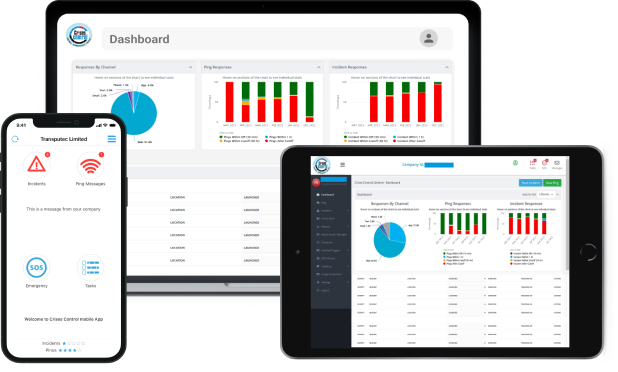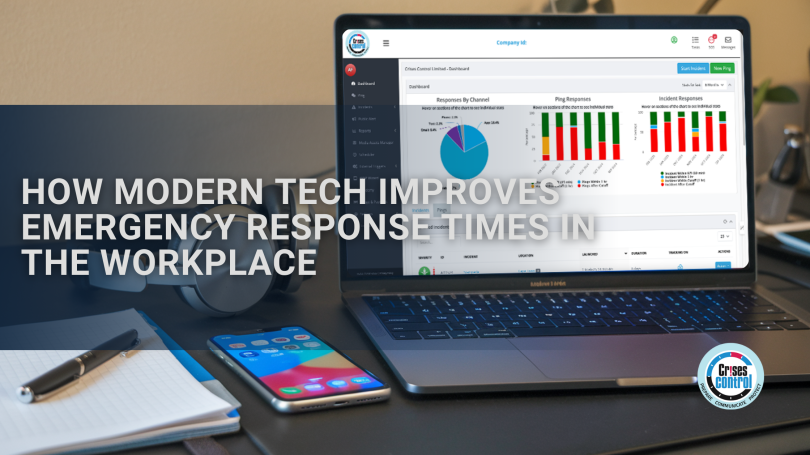Written by Anneri Fourie | Crises Control Executive
When an emergency strikes at work, whether it’s a fire, cyberattack, or medical crisis, how quickly your organisation responds can determine the outcome. Every second counts. Delays can lead to injuries, operational downtime, financial losses, and reputational damage.
Traditional emergency response methods, such as manual call chains, paper-based business continuity plans, and siloed communication, are slow and unreliable. They depend on human intervention, which increases the risk of delays and mistakes.
Technology has transformed emergency response, making it faster, more reliable, and more effective. Emergency response software, mass notification systems, and cloud-based business continuity platforms ensure that critical alerts reach employees instantly and that response plans are executed without delay.
This blog explores how modern technology is reducing response times, the key innovations that make a difference, and how Crises Control helps businesses stay prepared for any crisis.
Why Fast Emergency Response Matters in the Workplace
Emergencies in the workplace come in many forms; natural disasters, IT failures, security breaches, and health crises. A slow response can have serious consequences, including:
- Employee Safety Risks: Delayed communication can put employees in danger. Whether it’s a fire or an active threat, timely alerts can be the difference between safety and harm.
- Operational Disruptions: The longer it takes to contain an incident, the more business operations are affected. Downtime means lost productivity and revenue.
- Regulatory Non-Compliance: Many industries have strict regulations on emergency preparedness. Slow or inadequate responses can lead to legal penalties.
- Higher Recovery Costs: The longer an incident drags on, the more expensive the recovery process becomes. Immediate action helps minimise financial losses.
To protect employees and ensure business continuity, organisations need a system that enables real-time communication, structured response plans, and automated escalation. Traditional methods simply don’t provide the speed or reliability needed in an emergency.
How Modern Technology Improves Emergency Response
1. Mass Notification Systems: Immediate, Multi-Channel Alerts
One of the biggest breakthroughs in emergency response is mass notification technology. A reliable mass notification system ensures that critical messages are sent instantly and acknowledged by employees.
How It Works:
- Alerts are sent simultaneously via SMS, email, push notifications, and voice calls.
- Two-way communication allows employees to confirm receipt and request assistance if needed.
- Pre-set templates ensure quick message delivery, removing delays caused by manual drafting.
How Crises Control Helps:
Crises Control’s Ping Mass Notification System guarantees that emergency alerts reach employees, no matter where they are. Messages are automatically escalated until acknowledged, ensuring no one is left uninformed.
2. Automation and System Integrations: Reducing Human Delays
Manual emergency processes slow down response times. Calling individuals, sending emails, and coordinating teams take time—time that businesses don’t have during a crisis. Automated systems and smart integrations help remove these delays.
How It Works:
- Automated workflows trigger pre-defined response protocols the moment an incident is detected.
- System integrations with IoT devices, fire alarms, thermostats, and other sensors allow incidents to be triggered automatically.
- Instant task assignments ensure the right teams are alerted and know their roles without manual coordination.
How Crises Control Helps:
Crises Control’s Incident Management module enables businesses to automate emergency workflows and integrate with external systems, ensuring that critical incidents are detected and acted upon without delays.
3. Cloud-Based Business Continuity Platforms: Instant Access to Plans
Outdated, paper-based business continuity plans slow down emergency response. If key documents are unavailable, employees are left uncertain about what to do.
How It Works:
- Business continuity plans are stored securely in the cloud and accessible 24/7.
- Employees can retrieve step-by-step response instructions from any device.
- Plan updates are instantly available across all locations, ensuring no outdated information is used.
How Crises Control Helps:
With Crises Control’s Business Continuity Platform, businesses can digitise their emergency response plans, ensuring instant access and easy execution.
4. Geofencing and Location-Based Alerts: Targeted Notifications
Sending emergency alerts to an entire workforce isn’t always necessary. Location-based alerts allow businesses to send messages only to those directly affected.
How It Works:
- The system detects employees’ real-time locations and sends relevant alerts.
- Those outside the affected area receive different instructions to prevent unnecessary panic.
- Reduces confusion and ensures that only those at risk receive critical information.
How Crises Control Helps:
Crises Control’s geo-targeted mass notification system ensures that employees in danger zones receive timely updates, while those outside the area are given relevant instructions.
5. Mobile Emergency Response Apps: Critical Information on the Go
Not all employees work in a fixed location. Many are mobile, working remotely or across multiple sites. Relying on office-based systems or emails is ineffective when immediate action is required.
How It Works:
- Employees receive real-time emergency notifications via mobile devices.
- SOS panic buttons allow employees to signal distress instantly.
- Task management features ensure team members know their roles in an emergency.
How Crises Control Helps:
Crises Control’s mobile app provides real-time alerts, task assignments, and emergency plans directly to employees’ smartphones. Wherever they are, they stay informed and prepared.
Case Study: How Technology Cuts Emergency Response Times
A multinational manufacturing company struggled with slow emergency response times due to outdated communication methods. After implementing Crises Control’s mass notification system and incident management platform, they saw:
- 60% faster response times, reducing the impact of critical incidents.
- 85% acknowledgment rate for emergency alerts within the first five minutes.
- A significant reduction in operational downtime and financial losses.
By replacing manual processes with automated, cloud-based solutions, they improved employee safety and business resilience.
Explore more Case Studies
The Future of Emergency Response Technology
Technology will continue to evolve, making emergency response even faster and more effective. Key trends shaping the future include:
- Smarter System Integrations: More businesses are linking emergency response platforms with IoT devices, fire alarms, and environmental sensors to trigger automated alerts and actions.
- 5G and Enhanced Connectivity: Faster, more reliable networks will improve real-time communication and coordination during crises.
- Advanced Mobile Solutions: Emergency response apps will become even more sophisticated, offering real-time location tracking and improved team collaboration.
Crises Control remains at the forefront of innovation, continuously enhancing our platform to help businesses respond to emergencies quickly, efficiently, and with confidence.
Conclusion: Be Prepared with the Right Emergency Response Technology
A slow emergency response can lead to financial losses, reputational damage, and, most importantly, risks to human life. Investing in modern technology, such as emergency response software, mass notification systems, and cloud-based business continuity platforms, is essential to keeping employees safe and operations running smoothly.
Crises Control provides industry-leading emergency response solutions designed to help businesses reduce response times and improve crisis management.
Contact us today for a free personalised demo and see how we can help you enhance your emergency response strategy.
Request a FREE Demo








